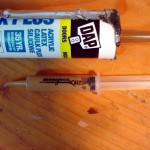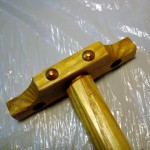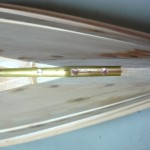 Lapstrake construction often wants a sealant applied where the laps meet. The sealant / adhesive of choice for this boat is 3M 5200, the “white goop” that easily, and tenaciously, gets all over everything. The boat’s designer wisely advised against using 5200 for the full length of each lap while planking. Looking back, you’ll see that I only used adhesive on the gains areas near the ends of the planks. Deferring the lap caulking made for a much neater job. It’s done this way: Use the tip of a screwdriver to make a shallow groove (about 1/8 inch) along the join of each lap. Then, fill that shallow groove with 5200. The technique works very well and avoids a big mess. To make it easy, I used a syringe with a quite small tip rather than the large nozzles usually found on caulking tubes. The same technique was used for the 5200 along the laps and for the simple acrylic latex caulk along the coamings. Oh yeah, the corner of a credit card is perfect for shaping these fine caulk lines.
Lapstrake construction often wants a sealant applied where the laps meet. The sealant / adhesive of choice for this boat is 3M 5200, the “white goop” that easily, and tenaciously, gets all over everything. The boat’s designer wisely advised against using 5200 for the full length of each lap while planking. Looking back, you’ll see that I only used adhesive on the gains areas near the ends of the planks. Deferring the lap caulking made for a much neater job. It’s done this way: Use the tip of a screwdriver to make a shallow groove (about 1/8 inch) along the join of each lap. Then, fill that shallow groove with 5200. The technique works very well and avoids a big mess. To make it easy, I used a syringe with a quite small tip rather than the large nozzles usually found on caulking tubes. The same technique was used for the 5200 along the laps and for the simple acrylic latex caulk along the coamings. Oh yeah, the corner of a credit card is perfect for shaping these fine caulk lines.
A couple of other small jobs. …
 The brackets that mount the seat back are designed to have rivets through them to prevent splitting when lifting the boat by the seat back. A few inches of #12 copper electric wire and a few roves provided the raw material. Tap tap tap did the rest.
The brackets that mount the seat back are designed to have rivets through them to prevent splitting when lifting the boat by the seat back. A few inches of #12 copper electric wire and a few roves provided the raw material. Tap tap tap did the rest.
 Half-round brass rub strips at the base of each stem offer a bit more protection and wrap up the last of the small assemblies. Well, maybe the penultimate small assembly. I’m considering a cane seat instead of a simple cushion but haven’t decided yet.
Half-round brass rub strips at the base of each stem offer a bit more protection and wrap up the last of the small assemblies. Well, maybe the penultimate small assembly. I’m considering a cane seat instead of a simple cushion but haven’t decided yet.
Harry specs the 12 foot Fiddlehead at 46 pounds weight when built as he does. My lumber is slightly different and I wondered if it would add extra weight. Without paint, the boat now weighs 47 pounds. Not bad. Actually, much better than I anticipated.
Leave a Reply